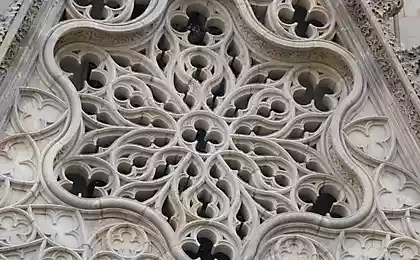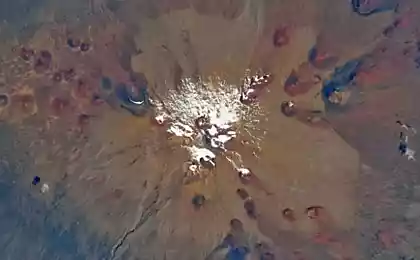3189
10 interesting facts about the Celts
The Celts left a great many stories and legends that are shrouded in mystery, intrigue, and, unfortunately, true. There are many misconceptions and false truths about them, but we're going to clear up some.
1. Origins
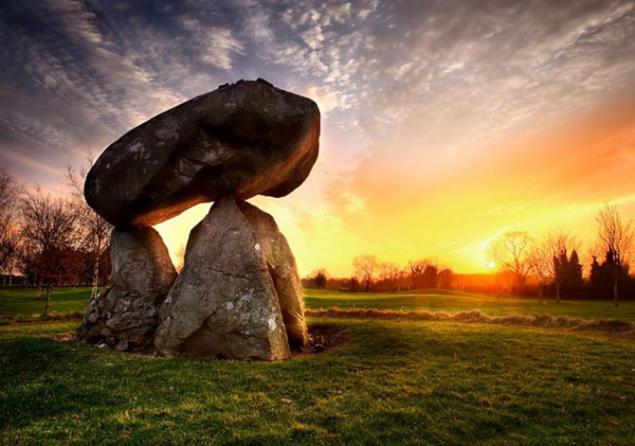
To be honest, no one really knows where they came from. Some historians argue that the Celts appeared in Britain around 1180 BC, in verily while others claim that it was still early. Nevertheless, it is generally accepted that the Celts began migrating from Central Europe in 400 BC They spread vo all directions until they were face to face with the Romans.
The problem was that their neighbor - Rome was united multinational empire and the Celts consisted of ten tribes, who fought against each other in the same chasto as they fought with the Romans. In kontse all, nekotorye of these tribes were destroyed polnostyu, some agreed to be ruled by the Romans, to verily while others were driven into the far corners of the known world: Ireland, Scotland and Wales.
2. They did not fight naked
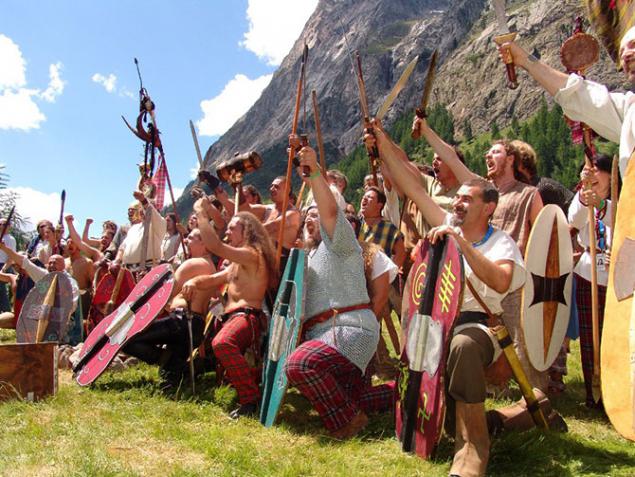
The mention of the Celts in the West makes people smile: "Oh, it's the guys who fought with bare gold rim on the neck (called Tork)?»
However, this is one of the biggest misconceptions about the Celts, which is absolutely ridiculous if you think a little. Delo is today chto all known information about the Celts come from Roman sources, and the Romans and the Celts were enemies. It's safe to say chto Roman historians, somewhat exaggerated.
When your enemy describes you and your life, it's safe to say that about himself he would write only good, but their enemy or bad or anything. It is in our time can be observed when American sources claim that during World War II decisive battles won only they and the Soviet Union led by Germany long war on the Eastern Front.
You can also view and from a different angle; Celts lived in a period known as the Iron Age. It was a time when iron was used instead of bronze for weapons, armor and tools. The Celts themselves produced good weapons such as swords, axes, spears, and two-handed hammers, metal plates and chain mail for use as armor. Knowing this, it is unlikely that the Celts dressed in cool weather on a naked body iron chain mail.
3. Druids
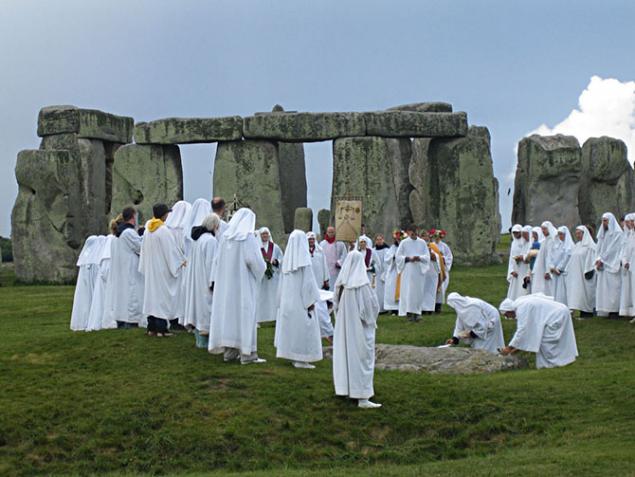
Celtic Druids were very honored. In addition, they are normally chto wore long white robes and sacrificed people, they do very interesting things. They advised the chiefs and kings, which make laws (such as advisers or parliament today), and they even acted as judges, implementing their own laws. Druids were considered clever and wise because they are 20 years of their lives to teach them skills. Their expertise ranged from astronomy to philosophy. Because they have extensive knowledge, they advised the people when to plant culture and even predict the future.
In addition, the Celtic Druids gave many traditions that are alive and Po today. The Druids believed the oak - a holy tree, because they believed that their gods live everywhere: in streams, rocks, trees. According to the beliefs of the Druids, the only thing more holy and magical than oak - a mistletoe that grows on oak. The Druids believed mistletoe miraculous properties, cut her golden sickle and performed purification rituals. Therefore, to this day, according to their traditions in English-speaking countries, there is a belief that if you were under the mistletoe, should definitely kiss.
4. Celtic women
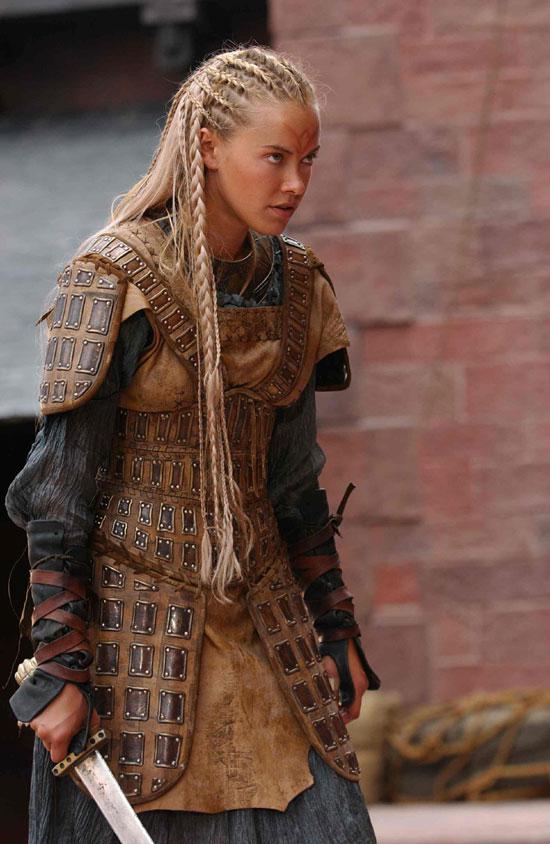
Women of the Celts could be powerful, had the right to own land, and even divorce, which was unheard of in the ancient world. Unlike Roman women, Celtic could climb up the social ladder or by inheritance status or, having achieved his own actions. If a woman was a landowner, during the war, she went to fight like a warrior on the orders of his king. Also, women warriors mogli devochek train young boys and the art of war.
They could even be beneficial to you. What's really interesting about the Celts, is that the children they were considered innocent and are protected by law. This is quite a contrast to the Roman world in which useless throwing children and left to die in the trash.
5. The Celts built excellent roads
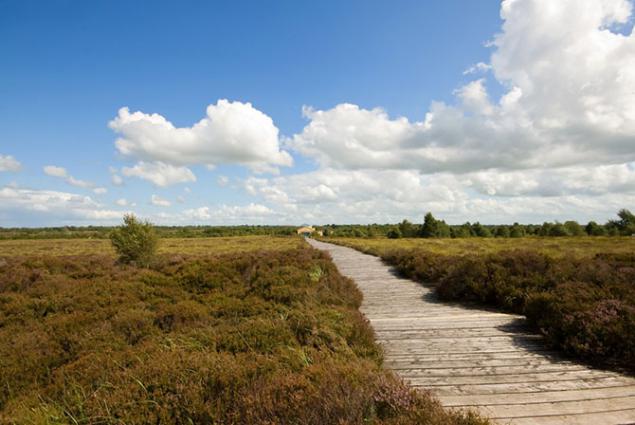
The Romans usually attributed to the fame that they were the first to build a reliable network of roads that connected all of Europe together. In the end, it is a historical fact, right? Wrong again! Contrary to popular belief, the Celts in the Pre-Roman samom actually built a network of roads to connect the wooden poseleny various Celtic tribes, so that they can engage in trade.
The problem with wood roads in chto they have not survived: by their very nature, most of them rotted. However, some boards have been found in bolotah Ireland, England and France. Because the Romans never actually been to Ireland, we can assert uverennostyu chto these old boards were actually part of the Celtic road system. In addition, you can view more information about the example of Celtic Roads Trails Corley (Corlea Trackway), which is located in Ireland. Here are preserved many of the old road, which has been partially restored to give an idea of how it might look like in their heyday.
6. Strange helmets
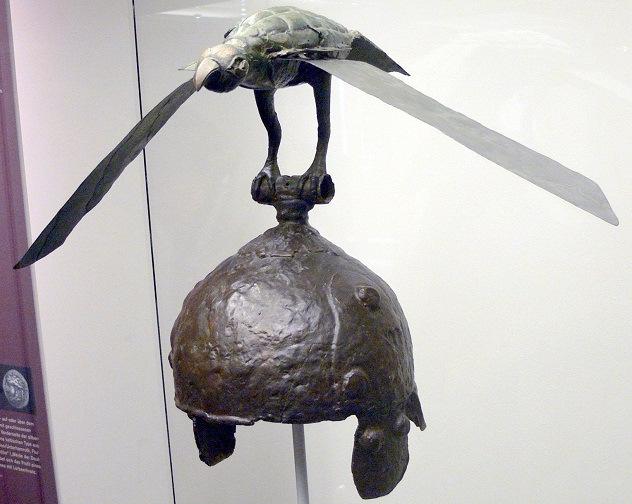
Now, kogda you know that the Celts had metal armor and chain mail, it is not hard to guess that they had and helmets. In fact, the Celts had a bunch of really crazy hats, Shout of kotoryh was discovered in Ciumeşti (Ciumesti), Romania (remember, the Celts were widespread throughout Europe?). There was found an old cemetery Iron Age from 34 graves. It turns out that these graves belonged to a rich Celtic chief, who was buried there, along with many objects, such as bronze weapons and armor (to serve him in the afterlife). Among these objects was found very strange helmet, on top of which was a picture of a large bird of prey.
What is really great in this helmet is the fact that the wings of birds have also been attached to the hinges. This meant that during human walking - bird flaps its wings. Historians believe that the helmet was a parade and in battle is not used.
7. The Celts loved battle
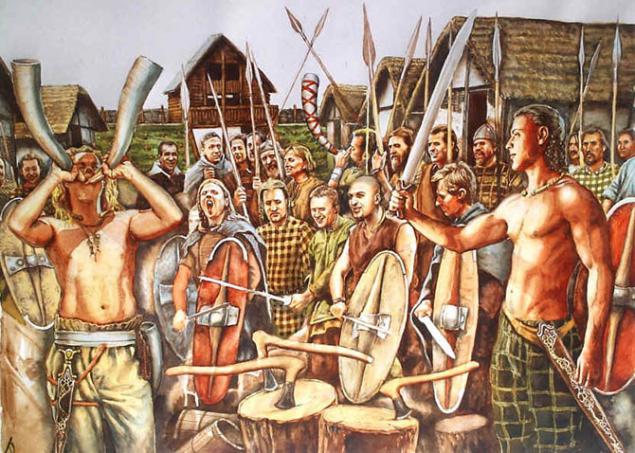
The Celts not only traveled, they also fought, and sometimes not at all free of charge. Celtic mercenaries in ancient times were known for their reputation of the brave and wild warriors. It is known that they are in the service of Pharaoh Ptolemy II, king of Ptolemaic Egypt. Mercenaries were nastolko good that Ptolemy II was afraid that they might seize Egypt, so he dropped them on a deserted island in the middle of the Nile.
The Greeks also met in battle with the Celts, who at that time were trying to expand their territory. This war is known as the Gallic invasion of the Balkans and the Delphic battle in 279 BC, in which the Celts were defeated. The Greek army was well organizovano srazhalos and cohesion, so that they could easily defeat the Celts fought piecemeal.
8. Headhunters
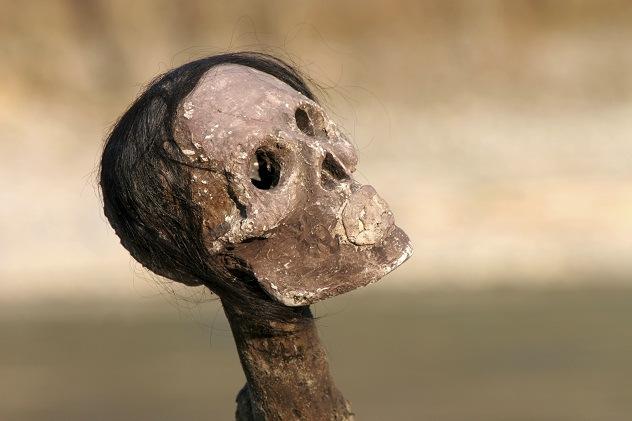
If you had to choose some interesting fact about samy keltah, so this is probably the fact that they were hunting for turtles. They believed that the best trophy in the battle was the severed head of an enemy. This fact can be explained by the fact that the Celts believed that the soul of a murdered man lived inside his head.
Collection of skulls meant a great honor and prestige of their owner, plus it gave them a reason to be proud. Celts decorate saddle their horses and their doors golovami severed his enemies.
9. The Celts were extremely rich
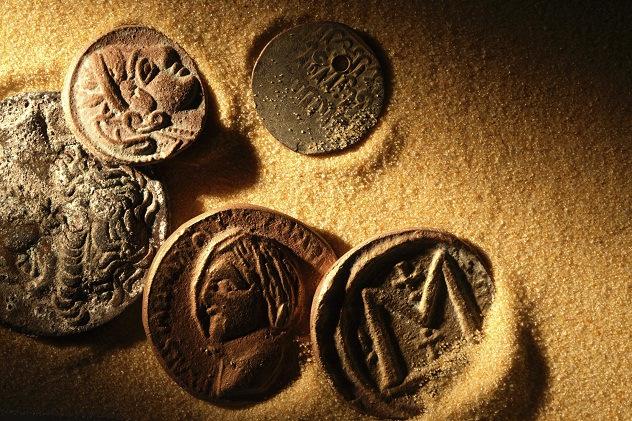
Here's a little history: in 58 BC Romans and Celts lived peacefully in their respective territories. However, at this time the novice politician Julius Caesar had huge debts, and he needed somewhere to get money. What he did. He invaded peaceful Celtic territory.
Gallic War is often regarded as the greatest military victory of Julius Caesar. This was the beginning of the rapid expansion of the Roman Empire. During the war, Caesar systematically beaten several Celtic chieftains, gaining control over more and more territory. This area, which was annexed to the Roman Empire was called Gaul (modern France). This led to the fact that Caesar has earned a lot of fame for his military successes. What is interesting, Caesar began a war under the pretext of protecting some of the other Celtic tribes. As a result of this "protection" in Gaul were exterminated more than a quarter million people (Celts). Caesar continued to "protect" the Celtic tribes until they were eventually all destroyed.
How does this relate to the wealth of the Celts? First of all, Caesar was a politician. He desperately needed the money to pay off his debts, and he needed a military conquest, to boost his political career. And in Celtic Gaul were rich deposits of gold. It is known that at that time in Gaul, employed more than 400 gold mines. Thus, the Celts were very rich, and no wonder why Caesar wanted to get their hands on control over these mines. Oddly enough, the Romans began to mint their own gold coins just after the conquest of Gaul.
10. The Celts were not simpletons
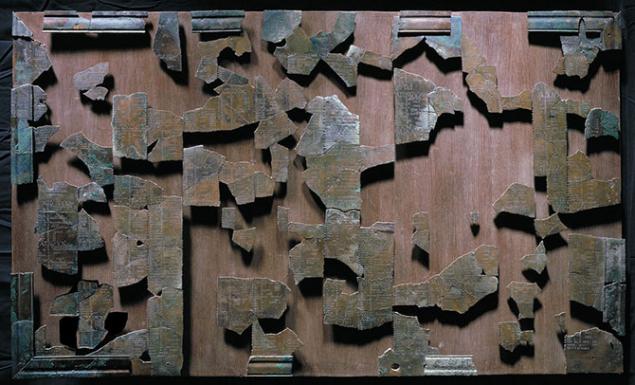
In addition, the Celts had serious knowledge of mathematics and astronomy. The Romans were the Julian kalendar, but the Celts had their own calendar. He called the Coligny calendar. It was found in Coligny, France (hence nazvanie) in 1897. Calendar consists of a series of mysterious metal objects decorated with intricate ornaments, lines, holes, numbers, letters and Celtic. In 1989, kalendar was finally deciphered. It has been found that it is a lunisolar calendar, which calculates the time of the year, based on the cycles of the sun and moon. This is a very accurate kalendar, which was peredovym for its time interval is much more accurate and his peers - the Roman calendar.
Perhaps more importantly, that this calendar is living proof that the Celts had a mathematical and scientific knowledge. Just to show how accurate was this thing, let's compare it and the Roman calendar. Roman calendar also considered sufficiently accurate for svoego time and lagged behind the real solar time only 11, 5 minutes per year. However, after a century were even slight inaccuracy increases with time. Calendar of Coligny was so accurate on sravneniyu with Rome, that if we were in the Roman calendar until today, the beginning of spring, we have pointed out in the middle of August, and the Celts still would have remained in the spring in the spring.
Here they are - the Celts.
1. Origins

To be honest, no one really knows where they came from. Some historians argue that the Celts appeared in Britain around 1180 BC, in verily while others claim that it was still early. Nevertheless, it is generally accepted that the Celts began migrating from Central Europe in 400 BC They spread vo all directions until they were face to face with the Romans.
The problem was that their neighbor - Rome was united multinational empire and the Celts consisted of ten tribes, who fought against each other in the same chasto as they fought with the Romans. In kontse all, nekotorye of these tribes were destroyed polnostyu, some agreed to be ruled by the Romans, to verily while others were driven into the far corners of the known world: Ireland, Scotland and Wales.
2. They did not fight naked

The mention of the Celts in the West makes people smile: "Oh, it's the guys who fought with bare gold rim on the neck (called Tork)?»
However, this is one of the biggest misconceptions about the Celts, which is absolutely ridiculous if you think a little. Delo is today chto all known information about the Celts come from Roman sources, and the Romans and the Celts were enemies. It's safe to say chto Roman historians, somewhat exaggerated.
When your enemy describes you and your life, it's safe to say that about himself he would write only good, but their enemy or bad or anything. It is in our time can be observed when American sources claim that during World War II decisive battles won only they and the Soviet Union led by Germany long war on the Eastern Front.
You can also view and from a different angle; Celts lived in a period known as the Iron Age. It was a time when iron was used instead of bronze for weapons, armor and tools. The Celts themselves produced good weapons such as swords, axes, spears, and two-handed hammers, metal plates and chain mail for use as armor. Knowing this, it is unlikely that the Celts dressed in cool weather on a naked body iron chain mail.
3. Druids

Celtic Druids were very honored. In addition, they are normally chto wore long white robes and sacrificed people, they do very interesting things. They advised the chiefs and kings, which make laws (such as advisers or parliament today), and they even acted as judges, implementing their own laws. Druids were considered clever and wise because they are 20 years of their lives to teach them skills. Their expertise ranged from astronomy to philosophy. Because they have extensive knowledge, they advised the people when to plant culture and even predict the future.
In addition, the Celtic Druids gave many traditions that are alive and Po today. The Druids believed the oak - a holy tree, because they believed that their gods live everywhere: in streams, rocks, trees. According to the beliefs of the Druids, the only thing more holy and magical than oak - a mistletoe that grows on oak. The Druids believed mistletoe miraculous properties, cut her golden sickle and performed purification rituals. Therefore, to this day, according to their traditions in English-speaking countries, there is a belief that if you were under the mistletoe, should definitely kiss.
4. Celtic women

Women of the Celts could be powerful, had the right to own land, and even divorce, which was unheard of in the ancient world. Unlike Roman women, Celtic could climb up the social ladder or by inheritance status or, having achieved his own actions. If a woman was a landowner, during the war, she went to fight like a warrior on the orders of his king. Also, women warriors mogli devochek train young boys and the art of war.
They could even be beneficial to you. What's really interesting about the Celts, is that the children they were considered innocent and are protected by law. This is quite a contrast to the Roman world in which useless throwing children and left to die in the trash.
5. The Celts built excellent roads

The Romans usually attributed to the fame that they were the first to build a reliable network of roads that connected all of Europe together. In the end, it is a historical fact, right? Wrong again! Contrary to popular belief, the Celts in the Pre-Roman samom actually built a network of roads to connect the wooden poseleny various Celtic tribes, so that they can engage in trade.
The problem with wood roads in chto they have not survived: by their very nature, most of them rotted. However, some boards have been found in bolotah Ireland, England and France. Because the Romans never actually been to Ireland, we can assert uverennostyu chto these old boards were actually part of the Celtic road system. In addition, you can view more information about the example of Celtic Roads Trails Corley (Corlea Trackway), which is located in Ireland. Here are preserved many of the old road, which has been partially restored to give an idea of how it might look like in their heyday.
6. Strange helmets

Now, kogda you know that the Celts had metal armor and chain mail, it is not hard to guess that they had and helmets. In fact, the Celts had a bunch of really crazy hats, Shout of kotoryh was discovered in Ciumeşti (Ciumesti), Romania (remember, the Celts were widespread throughout Europe?). There was found an old cemetery Iron Age from 34 graves. It turns out that these graves belonged to a rich Celtic chief, who was buried there, along with many objects, such as bronze weapons and armor (to serve him in the afterlife). Among these objects was found very strange helmet, on top of which was a picture of a large bird of prey.
What is really great in this helmet is the fact that the wings of birds have also been attached to the hinges. This meant that during human walking - bird flaps its wings. Historians believe that the helmet was a parade and in battle is not used.
7. The Celts loved battle

The Celts not only traveled, they also fought, and sometimes not at all free of charge. Celtic mercenaries in ancient times were known for their reputation of the brave and wild warriors. It is known that they are in the service of Pharaoh Ptolemy II, king of Ptolemaic Egypt. Mercenaries were nastolko good that Ptolemy II was afraid that they might seize Egypt, so he dropped them on a deserted island in the middle of the Nile.
The Greeks also met in battle with the Celts, who at that time were trying to expand their territory. This war is known as the Gallic invasion of the Balkans and the Delphic battle in 279 BC, in which the Celts were defeated. The Greek army was well organizovano srazhalos and cohesion, so that they could easily defeat the Celts fought piecemeal.
8. Headhunters

If you had to choose some interesting fact about samy keltah, so this is probably the fact that they were hunting for turtles. They believed that the best trophy in the battle was the severed head of an enemy. This fact can be explained by the fact that the Celts believed that the soul of a murdered man lived inside his head.
Collection of skulls meant a great honor and prestige of their owner, plus it gave them a reason to be proud. Celts decorate saddle their horses and their doors golovami severed his enemies.
9. The Celts were extremely rich

Here's a little history: in 58 BC Romans and Celts lived peacefully in their respective territories. However, at this time the novice politician Julius Caesar had huge debts, and he needed somewhere to get money. What he did. He invaded peaceful Celtic territory.
Gallic War is often regarded as the greatest military victory of Julius Caesar. This was the beginning of the rapid expansion of the Roman Empire. During the war, Caesar systematically beaten several Celtic chieftains, gaining control over more and more territory. This area, which was annexed to the Roman Empire was called Gaul (modern France). This led to the fact that Caesar has earned a lot of fame for his military successes. What is interesting, Caesar began a war under the pretext of protecting some of the other Celtic tribes. As a result of this "protection" in Gaul were exterminated more than a quarter million people (Celts). Caesar continued to "protect" the Celtic tribes until they were eventually all destroyed.
How does this relate to the wealth of the Celts? First of all, Caesar was a politician. He desperately needed the money to pay off his debts, and he needed a military conquest, to boost his political career. And in Celtic Gaul were rich deposits of gold. It is known that at that time in Gaul, employed more than 400 gold mines. Thus, the Celts were very rich, and no wonder why Caesar wanted to get their hands on control over these mines. Oddly enough, the Romans began to mint their own gold coins just after the conquest of Gaul.
10. The Celts were not simpletons

In addition, the Celts had serious knowledge of mathematics and astronomy. The Romans were the Julian kalendar, but the Celts had their own calendar. He called the Coligny calendar. It was found in Coligny, France (hence nazvanie) in 1897. Calendar consists of a series of mysterious metal objects decorated with intricate ornaments, lines, holes, numbers, letters and Celtic. In 1989, kalendar was finally deciphered. It has been found that it is a lunisolar calendar, which calculates the time of the year, based on the cycles of the sun and moon. This is a very accurate kalendar, which was peredovym for its time interval is much more accurate and his peers - the Roman calendar.
Perhaps more importantly, that this calendar is living proof that the Celts had a mathematical and scientific knowledge. Just to show how accurate was this thing, let's compare it and the Roman calendar. Roman calendar also considered sufficiently accurate for svoego time and lagged behind the real solar time only 11, 5 minutes per year. However, after a century were even slight inaccuracy increases with time. Calendar of Coligny was so accurate on sravneniyu with Rome, that if we were in the Roman calendar until today, the beginning of spring, we have pointed out in the middle of August, and the Celts still would have remained in the spring in the spring.
Here they are - the Celts.












